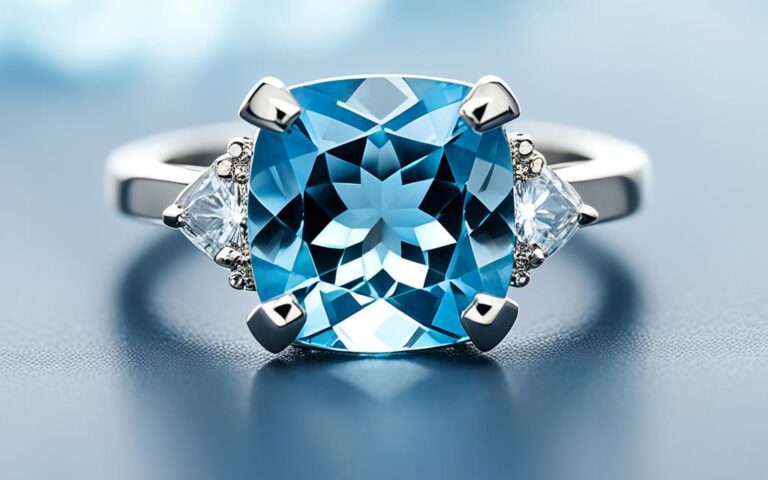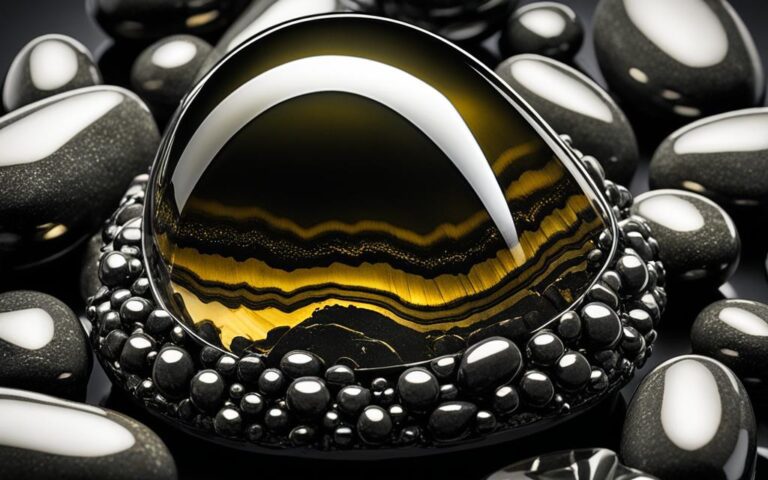Malachite: The Vibrant Green Mineral Gem
Did you know malachite, a captivating copper carbonate mineral, can be up to 4 times heavier than other gemstones of the same size? This amazing fact shows how special malachite is. Its stunning green colors and long history in jewelry and decor have won hearts worldwide.
Malachite is a copper carbonate hydroxide mineral with the chemical formula Cu2CO3(OH)2. It’s famous for its bright, vivid green color and unique banded or swirling patterns. These patterns come from how it crystallizes and forms within rocks. This semi-precious stone is loved for its beauty and versatility, often used in jewelry and decor.
Key Takeaways
- Malachite is a copper carbonate hydroxide mineral with a vibrant green color and unique banded patterns.
- It has a relatively soft hardness of 3.5-4 on the Mohs scale, but a high specific gravity of 3.6-4.0, making it dense and heavy.
- Malachite is typically found in the oxidation zones of copper ore deposits and is often associated with other copper minerals.
- Malachite has been used for centuries in various applications, including jewelry, cosmetics, amulets, and pigments for paint.
- The rich history and symbolism of malachite contribute to its enduring popularity among gemstone enthusiasts and collectors.
Introduction to Malachite
Definition and Description
Malachite is a bright green mineral with the chemical name Cu2CO3(OH)2. It gets its color from a lot of copper, about 50-60%. You can find it in the top part of copper mines, often with other copper minerals like azurite and chrysocolla.
Etymology and Historical Background
The name “malachite” comes from the Greek words “molochites lithos”, meaning “mallow-green stone”. It looks like the leaves of the mallow plant. People have been mining and using malachite since around 4000 BCE.
At the Great Orme Mines in Britain, they mined it a lot about 3,800 years ago. Malachite has always been valued for its beauty and as a gemstone.
“Malachite has been linked to protection, healing, luck, and fertility in old times. Now, it’s seen as a symbol of change, growth, and new starts.”
| Malachite Properties | Details |
|---|---|
| Copper Content | 50-60% |
| Common Locations | Russia, Democratic Republic of Congo, Zambia, Mexico, United States, Australia |
| Earliest Use | 4000 BCE |
| Mohs Hardness | 3.5-4 |
Physical Characteristics of Malachite
Malachite is a mineral that catches the eye with its bright green colors. It can be light, dark, or even blackish green. Often, it shows off a banded or concentric pattern.
Appearance and Color Variations
Malachite gets its vivid green color from copper, carbon, and hydroxide. This mix makes it stand out. The color changes because of impurities and its structure inside.
Crystal Structure and Formation
Malachite forms in a special crystal system, often as botryoidal, fibrous, or stalagmitic masses. Rarely, it can be found as slender crystals. It usually forms near copper deposits, where the right chemicals come together.
Common Locations and Mining Areas
Malachite is found in many places rich in copper. Big amounts were mined in the Ural Mountains of Russia and in the Democratic Republic of the Congo. Other places include Gabon, Zambia, Namibia, Mexico, Australia, and the southwestern United States.
People mine malachite for its beauty or for copper. They use both open-pit and underground methods. This mining affects the environment.
| Location | Malachite Mining Significance |
|---|---|
| Ural Mountains, Russia | Historically significant malachite mining region |
| Democratic Republic of the Congo | Major producer of malachite and other copper minerals |
| Southwestern United States | Notable malachite deposits and mining activities |
Malachite’s looks, from its colors to its structure, make it popular as a gemstone and decoration.
Types of Malachite
Malachite is known for its beautiful green colors. But, it comes in many forms and types. You can find it in massive, botryoidal, and crystalline forms. It can also be mixed with other minerals.
One type is the malachite-azurite mix. It combines malachite with the blue mineral azurite. This mix creates stunning green and blue colors with unique patterns. Another type is the malachite-chrysocolla mix. It blends malachite with chrysocolla, a copper silicate mineral. This mix produces beautiful colors and textures not found in pure malachite.
| Malachite Type | Description |
|---|---|
| Massive | Solid, uniform green color without distinct crystals or patterns. |
| Botryoidal | Resembling a cluster of grapes, with rounded, globular shapes. |
| Crystalline | Formed as distinct, well-defined crystals, often with a prismatic habit. |
| Malachite-Azurite | Intergrowths of malachite and the blue mineral azurite, creating unique color patterns. |
| Malachite-Chrysocolla | Combinations of malachite with the copper silicate mineral chrysocolla, yielding distinct hues and textures. |
These types of malachite and varieties of malachite show how versatile this mineral is. They form unique and beautiful specimens. Learning about these types can deepen your appreciation for malachite.
“Malachite is a true marvel of nature, with its vibrant green hues and mesmerizing patterns. Exploring the different types and varieties of this mineral is a journey of discovery into the remarkable diversity of Earth’s treasures.”
Scientific Properties of Malachite
Malachite is a gemstone known for its beautiful green colors and special properties. Let’s explore what makes this mineral so unique.
Chemical Composition
Malachite’s formula is Cu2CO3(OH)2. It’s made of copper, carbonate, and hydroxide. These elements give malachite its green color and help it stay stable.
Mohs Hardness Scale Rating
Malachite scores 3.5-4 on the Mohs hardness scale. This means it’s quite soft. Its softness makes it easy to shape and polish, perfect for decorations and art.
Crystal System and Habit
Malachite forms in the monoclinic crystal system. It grows in different shapes like botryoidal, fibrous, or stalagmitic masses. These shapes make malachite look unique and beautiful.
Optical Properties
Malachite is a biaxial (-) mineral. It has refractive indices of nα = 1.655, nβ = 1.875, and nγ = 1.909. Its birefringence is δ = 0.254. Malachite can be translucent or opaque, adding to its versatility.
| Property | Value |
|---|---|
| Chemical Composition | Cu2CO3(OH)2 |
| Mohs Hardness | 3.5-4 |
| Crystal System | Monoclinic |
| Refractive Indices | nα = 1.655, nβ = 1.875, nγ = 1.909 |
| Birefringence | δ = 0.254 |
| Diaphaneity | Translucent to Opaque |
Malachite’s special properties make it useful in many areas. It’s used in decorations, research, and for its historical value.
Metaphysical and Healing Properties
Malachite is known for its amazing metaphysical and healing properties. It’s a top choice in holistic wellness circles. This vibrant green mineral is linked to growth, change, and nature’s power. It’s seen as protective, keeping bad vibes away and helping with emotional healing.
Spiritual Significance and Symbolism
Malachite holds deep spiritual meaning. It stands for personal growth, renewal, and life’s cycles. Its green color connects us to Earth’s energy, deepening our love for nature. It’s used in meditation to help us know ourselves better, heal past wounds, and beat fears.
Healing Properties and Benefits
- Regulates the menstrual cycle and eases labor pains
- Supports the immune system and treats conditions like asthma, arthritis, and epilepsy
- Aids in the release of toxins and balances mood swings
- Enhances emotional well-being, combating depression and anxiety
Emotional Well-being
Malachite focuses on the Heart Chakra for emotional healing and empathy. Placing it on the heart helps balance emotions, improve relationships, and understand oneself better. It’s used to break free from negative habits, leading to personal growth and change.
| Malachite Metaphysical Properties | Malachite Spiritual Meaning | Malachite Healing Properties | Malachite Emotional Benefits |
|---|---|---|---|
| Growth, transformation, protection | Connection to nature, self-awareness, release of traumas | Immune system support, toxin release, mood balance | Emotional healing, empathy, personal growth |
“Malachite is a powerful crystal that can help us connect with the natural world and unlock our own potential for growth and transformation.”
Malachite
Malachite is a vibrant green mineral that has been fascinating humans for centuries. It’s known for its unique patterns and shiny look. People love it not just for how it looks, but also for its believed healing powers.
This gemstone is linked to fire, helping with feelings of anger or frustration. It works with the Heart chakra to balance emotions and heal. It’s great for reducing stress and helping with past traumas.
Malachite also touches the Solar Plexus chakra, boosting confidence and motivation. Its color, a mix of green and dark swirls, reminds us of nature and growth. It symbolizes harmony and abundance.
Malachite is known for its healing effects on the mind, emotions, and body. It supports emotional healing, fertility, and protects against negative energy. It’s called the “midwife stone” because it’s linked to childbirth.
This mineral is great at removing negative energy and pollutants. It can clean pollutants and protect against radiation, which is useful for those near radiation sources.
| Malachite Properties | Benefits |
|---|---|
| Copper Carbonate Mineral | Conducts energy, purifies the blood, influences the core of beliefs and patterns |
| Chakra Activation and Clearing | Activates and clears chakras, enhances spiritual guidance |
| Physical Healing | Treats blood pressure, asthma, arthritis, epilepsy, fractures, swollen joints, tumors, and more |
| Cellular and Immune System Support | Aligns DNA and cellular structure, boosts the immune system, stimulates liver function, reduces tissue acidification |
Malachite’s pattern helps with scrying and accessing deep insights. It can be placed on the body to activate different benefits. For example, on the third eye for psychic vision, the heart for balance, or the solar plexus for emotional healing.
“Malachite is a remarkable mineral that has captivated humanity for centuries. Its vibrant green color and unique banded patterns make it a true work of art, while its believed metaphysical and healing properties make it a cherished gemstone in spiritual and wellness practices.”
In summary, malachite is a captivating gem that offers many benefits. It’s not just beautiful but also has deep healing powers. Whether for decoration or spiritual use, malachite continues to inspire and enchant people.
Malachite in Jewelry and Decorative Arts
Malachite, a vibrant green mineral, has been a favorite for jewelry and decorative arts for centuries. Its striking color and unique patterns make it popular for creating beautiful objects. From the Malachite Room in the Hermitage Museum to the Red Queen’s funerary mask, malachite is known for its beauty and versatility.
In malachite jewelry, the gemstone is turned into stunning pieces like rings, necklaces, and earrings. Its Mohs hardness of 3.5 to 4.5 means it’s a bit soft, so it needs special care. But, it’s more affordable than other gems, making it accessible to many.
Malachite decorative arts are also in high demand. Its beauty is perfect for small sculptures and inlays. People also love it for its meaning of protection and growth, making it great for home decor and gifts.
Malachite’s use in art shows its lasting charm. As an old copper ore, it still inspires artists and designers. Its vibrant green and unique patterns capture the hearts of many.
“Malachite’s vivid green color and unique banded patterns have made it a perennial favorite for jewelry and decorative arts throughout history.”
Natural malachite is the top choice, but synthetic malachite is made for research. It’s not sold because natural malachite is plentiful and cheaper. Malachite’s rich history and beauty keep inspiring people in art and design.
Malachite Mining and Environmental Impact
Malachite, a vibrant green mineral, is highly valued worldwide. But mining it can harm the environment. We must look at these effects closely.
Malachite mining can destroy habitats and harm biodiversity. Mining methods can clear out plants and disrupt ecosystems. This can hurt local plants and animals. Also, mining waste can pollute water and soil, making things worse.
- Malachite is found in significant deposits in the Democratic Republic of Congo, Russia, and Australia, among other regions.
- The Ural Mountains in Russia and the Katanga region in the Democratic Republic of Congo are renowned for their malachite mines.
- Malachite ranks between 3.5 and 4 on the Mohs scale of hardness, making it a relatively soft mineral.
To lessen the harm from malachite mining, we need responsible mining and good waste management. There are efforts to find greener ways to get this mineral. For example, using chitin nanocrystals in the mining process is being explored. This can help protect the ecosystems around malachite.
The demand for malachite is rising, so mining must be careful. By using sustainable methods and new ideas, mining can balance its benefits with protecting nature. This way, we can enjoy malachite without harming the environment.
Malachite in History and Ancient Cultures
Malachite, a vibrant green mineral, has a long history that goes back thousands of years. It was first mined around 4000 BCE. The Great Orme Mines in Britain started mining it about 3,800 years ago.
Ancient civilizations like the Egyptians, Greeks, and Romans loved malachite. They used it in jewelry, ornaments, and even as a green paint pigment.
In the Middle Ages, people thought malachite could protect and heal. It was used in talismans and amulets. The Russian tsars loved malachite too. They used it a lot in their palaces and castles, like the Malachite Salon in the Winter Palace in St. Petersburg.
Malachite was important in ancient cultures because of its unique look and meaning. It was seen as a symbol of protection, fertility, and new life. In Italy, people wore malachite pieces to keep away the Evil Eye.
Malachite was also useful for more than just decoration. In the ancient world, merchants thought it could help make business deals profitable. It was also believed to bring wealth and protect travelers and camel riders from accidents.
Malachite’s history and cultural importance show how much it meant to ancient civilizations. From the Egyptians to the Russians, this mineral has always fascinated people. It’s a symbol of beauty and cultural significance.
“Malachite was highly valued by ancient civilizations, including the Egyptians, Greeks, and Romans, who used it for jewelry, ornaments, and as a pigment in green paints.”
Identifying and Caring for Malachite
Malachite is a gemstone known for its bright green color and unique patterns. It has a Mohs hardness of 3.5-4, which means it’s soft and can easily get scratched or damaged. It’s important to know how to care for and identify malachite to keep it looking beautiful.
Identifying Malachite
To spot malachite, look for its vibrant green color, which can be light or deep. Its patterns, like bands or circles, are also a giveaway. Plus, it’s softer than many other gemstones.
Caring for Malachite
- Handle malachite gently to avoid scratches or chips.
- Avoid exposing malachite to acids, harsh chemicals, or extreme temperatures, as these can cause etching and discoloration.
- Clean malachite with a soft cloth and mild soap and water, then dry it thoroughly.
- Store malachite away from direct sunlight to preserve its vivid green color.
Keeping malachite clean and stored right is key to its beauty. By following these tips, your malachite jewelry or decorations will stay looking great for a long time.
“Malachite is a stunning and versatile mineral that deserves the utmost care and attention to maintain its natural beauty.”
Malachite Value and Market
Malachite is a semi-precious gemstone known for its beautiful green colors and unique patterns. Its value changes a lot, based on several factors. High-quality malachite with clear banding and bright colors can be very expensive. This is true especially if it comes from famous mines like the Ural Mountains in Russia.
Malachite is used in many ways, from jewelry to decorative arts and collector’s items. Its demand is strong, especially among those who love its beauty and spiritual qualities. The price of malachite varies a lot. This depends on how rare it is, its size, and its quality.
| Malachite Quality | Average Price Range (per carat) |
|---|---|
| Low-grade (Heavily Included, Dull Color) | $5 – $15 |
| Medium-grade (Good Color, Moderate Inclusions) | $15 – $50 |
| High-grade (Vivid Color, Minimal Inclusions) | $50 – $150 |
| Rare Specimens (Large Size, Museum-quality) | $150 – $500+ |
The value of malachite shows how rare, beautiful, and culturally important it is. Because of this, it remains a favorite among those who love nature’s beauty.
Conclusion
Malachite has always caught the eye and heart of many. Its bright green color and unique patterns make it a gemstone everyone wants. It’s used in jewelry, decorative arts, and as a copper source.
People also see malachite as having special spiritual and healing powers. This makes it important in spiritual and wellness practices.
However, mining malachite can harm the environment. But, efforts to mine it responsibly help protect it for the future. Malachite teaches us about changing, being strong emotionally, and clear in our thoughts. It shows us how to grow and explore our inner selves.
In the end, malachite is a mineral full of art and spirit. Its beauty and importance in art, culture, and health will always be there for us to discover.






